Exploring Procedural Content Generation of Environments for Virtual Museums: A Mixed-Initiative Approach
Abstract
1. Introduction
1.1. Museum and Interactive Software
1.2. Challenges in Virtual Museum Development
1.3. Virtual Museum of Maule
1.4. Motivation
2. Materials and Methods
2.1. Awareness and Suggestion
- Stage 1 (Room Generator): In the first stage, the BSP method will be used to generate rooms of various sizes and positions within the virtual museum. The goal is to create multiple room configurations that offer greater flexibility in spatial design. This approach aims to reduce the monotony of traditional layouts and enrich the visitor experience through dynamic spatial arrangements. This stage follows a human-in-the-loop process consisting of five steps: (1A) the developer adjusts the parameters of the room generation module, (1B) the system generates multiple room configurations, (1C) the developer evaluates the generated layouts, (1D) if unsatisfactory, the parameters are readjusted for a new iteration, and (1E) the most suitable layout is selected for the next stage. To evaluate the performance of this stage along with Stage 2, a grid-based assessment will be conducted to identify the optimal operator configurations for the room generation task.
- Stage 2 (Artwork Arrangement): This stage utilizes GAs within the Artwork Arrangement module to optimize the placement of artworks within the generated rooms. Given a museum layout and a set of artworks, the GAs will maximize space utilization and provide visually appealing, diverse configurations. The GA operator settings will be adjusted to balance generation speed with deep exploration of the solution space. Stage 2 follows a similar human-in-the-loop approach, consisting of five steps: (2A) the user adjusts system parameters for artwork distribution, (2B) the system generates a distribution of artworks, (2C) the user evaluates the generated distribution, (2D) if unsatisfactory, the parameters are readjusted for a new iteration, and (2E) the final distribution is selected. After this stage, manual refinements can be performed by developers or curators to fine-tune the final virtual museum. This adjustment will be evaluated together with Stage 1 through grid-based assessments to determine the optimal combination of operators.
2.2. Development
2.3. Artwork Arrangement
3. Results
3.1. Experimental Setup
3.2. Fitness Analysis
3.3. Computational Time Analysis
3.4. Comparative Analysis of Top Combinations
3.5. Path Verification Module
4. Discussion
5. Conclusions and Future Work
Future Work
Author Contributions
Funding
Data Availability Statement
Conflicts of Interest
Abbreviations
| PSO | Particle Swarm Optimization |
| GA | Genetic Algorithm |
| BSP | Binary Space Partitioning |
| WFC | Wave Function Collapse |
| HCI | Human–Computer Interaction |
Appendix A. Analysis of System Performance
Appendix A.1. Time Performance
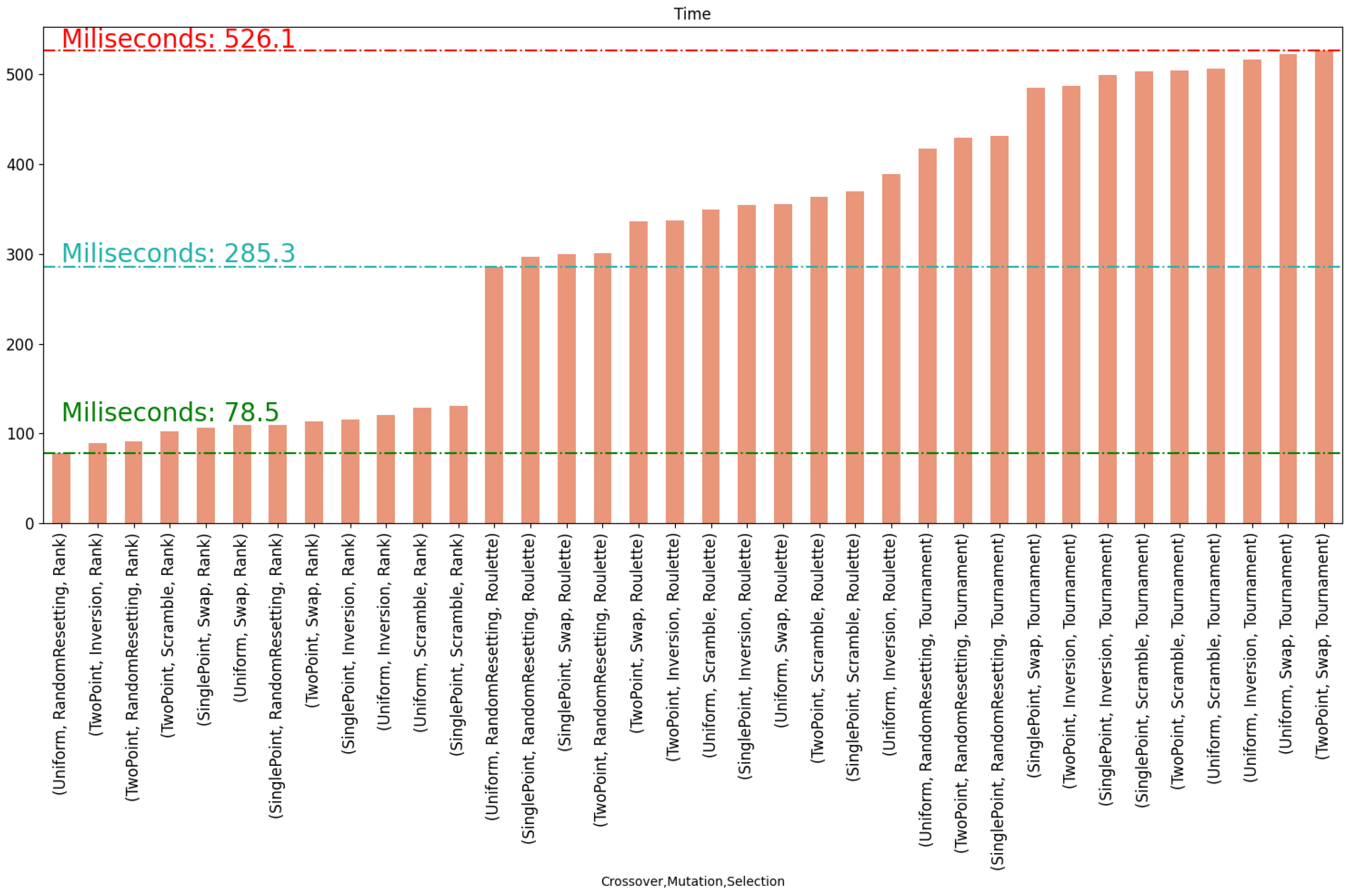
Appendix A.2. Fitness Performance
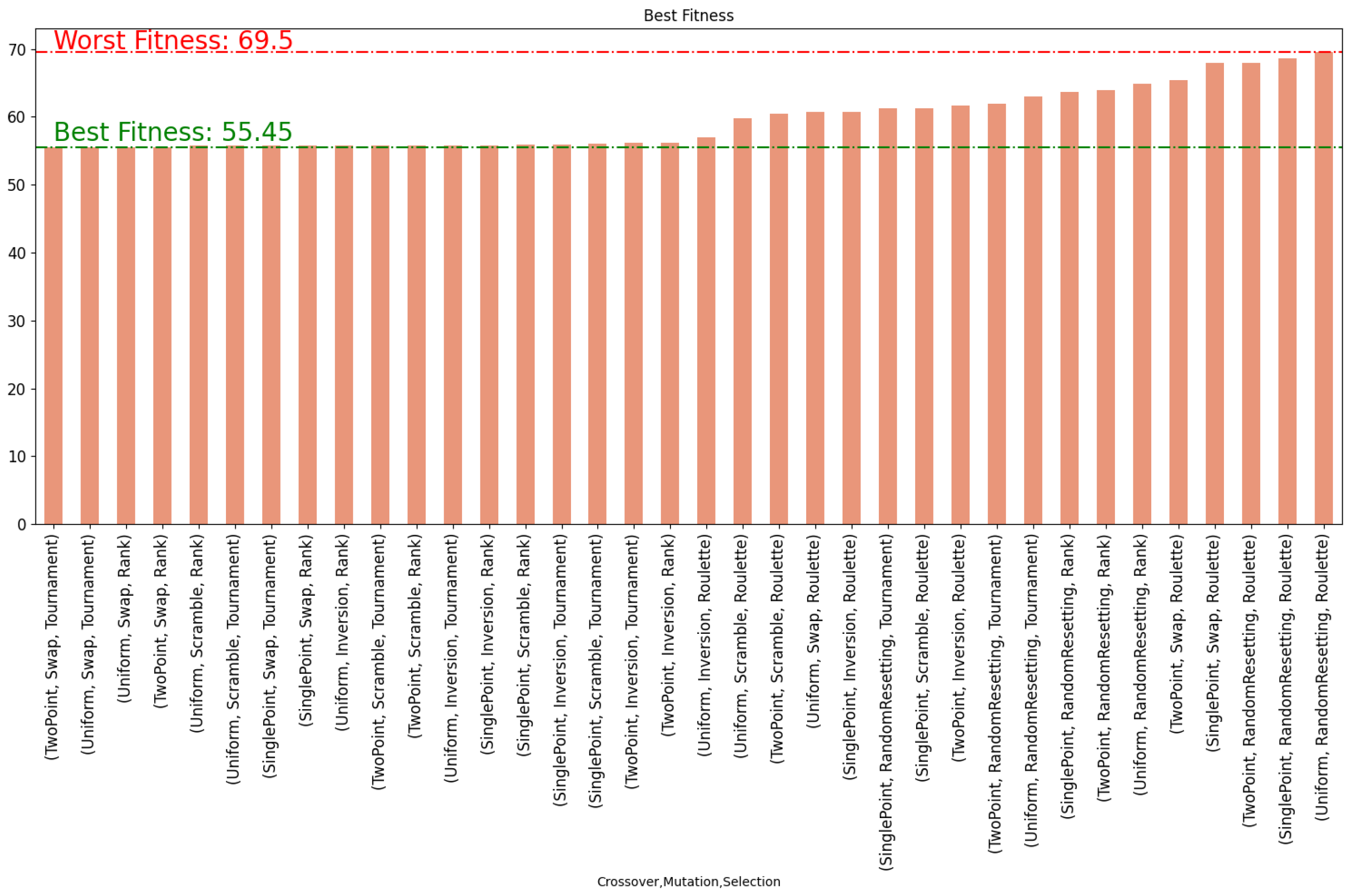
Appendix A.3. Valid Choromosomes Performance

Appendix A.4. Time and Valid Chromosomes Comparison for Operators with Best Average Fitness
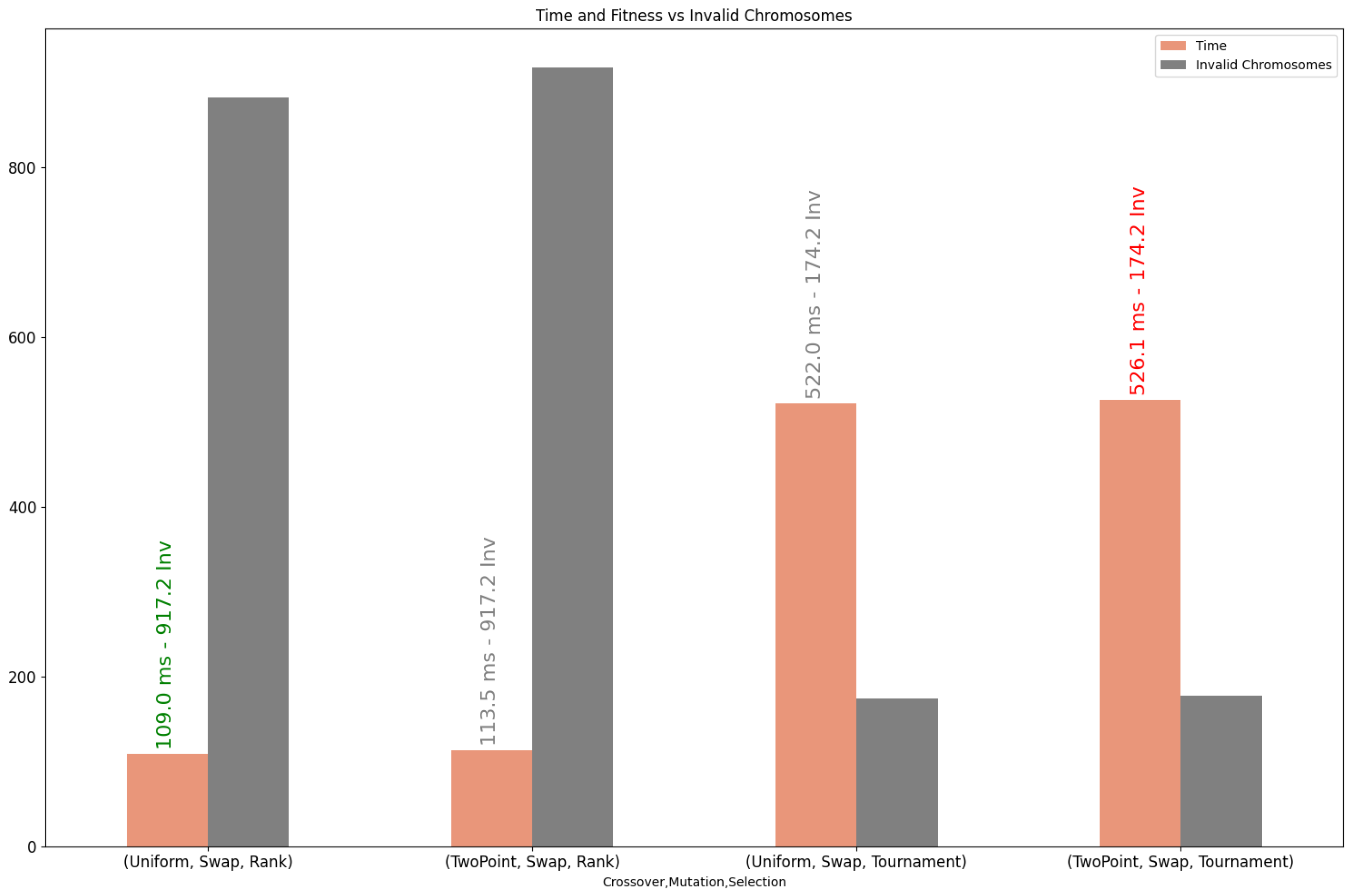
References
- Van Huy, N. The role of museums in the preservation of living heritage: Experiences of the Vietnam Museum of Ethnology. Int. J. Intang. Herit. 2006, 1, 35–41. [Google Scholar]
- Agostino, D.; Arnaboldi, M. From preservation to entertainment: Accounting for the transformation of participation in Italian state museums. Account. Hist. 2021, 26, 102–122. [Google Scholar] [CrossRef]
- Yoshida, K. The museum and the intangible cultural heritage. Mus. Int. 2004, 56, 108–112. [Google Scholar] [CrossRef]
- Chianese, A.; Piccialli, F. Designing a smart museum: When cultural heritage joins IoT. In Proceedings of the 2014 Eighth International Conference on Next Generation Mobile Apps, Services and Technologies, Oxford, UK, 10–12 September 2014; IEEE: Piscataway, NJ, USA, 2014; pp. 300–306. [Google Scholar]
- Trunfio, M.; Lucia, M.D.; Campana, S.; Magnelli, A. Innovating the cultural heritage museum service model through virtual reality and augmented reality: The effects on the overall visitor experience and satisfaction. J. Herit. Tour. 2022, 17, 1–19. [Google Scholar]
- Pisoni, G.; Díaz-Rodríguez, N.; Gijlers, H.; Tonolli, L. Human-centered artificial intelligence for designing accessible cultural heritage. Appl. Sci. 2021, 11, 870. [Google Scholar] [CrossRef]
- Valeonti, F.; Bikakis, A.; Terras, M.; Speed, C.; Hudson-Smith, A.; Chalkias, K. Crypto collectibles, museum funding and OpenGLAM: Challenges, opportunities and the potential of Non-Fungible Tokens (NFTs). Appl. Sci. 2021, 11, 9931. [Google Scholar] [CrossRef]
- Falk, J.H. The Value of Museums: Enhancing Societal Well-Being; Rowman & Littlefield: Lanham, MD, USA, 2021. [Google Scholar]
- Besoain, F.; Jego, L.; Gallardo, I. Developing a virtual museum: Experience from the design and creation process. Information 2021, 12, 244. [Google Scholar] [CrossRef]
- Li, Q.; Wang, P.; Liu, Z.; Wang, C. How generous interface affect user experience and behavior: Evaluating the information display interface for museum cultural heritage. Comput. Animat. Virtual Worlds 2024, 35, e2212. [Google Scholar]
- Kirchberg, V.; Tröndle, M. The museum experience: Mapping the experience of fine art. Curator Mus. J. 2015, 58, 169–193. [Google Scholar]
- López Sintas, J.; García Álvarez, E.; Pérez Rubiales, E. Art museum visitors: Interaction strategies for sharing experiences. Mus. Manag. Curatorship 2014, 29, 241–259. [Google Scholar]
- Dal Falco, F.; Vassos, S. Museum experience design: A modern storytelling methodology. Des. J. 2017, 20, S3975–S3983. [Google Scholar] [CrossRef]
- Soren, B.J. Museum experiences that change visitors. Mus. Manag. Curatorship 2009, 24, 233–251. [Google Scholar] [CrossRef]
- Wang, S.; Duan, Y.; Yang, X.; Cao, C.; Pan, S. ‘Smart Museum’ in China: From technology labs to sustainable knowledgescapes. Digit. Scholarsh. Humanit. 2023, 38, 1340–1358. [Google Scholar] [CrossRef]
- He, C.; Lu, Y. Design and communication of digital museum based on computer and Internet technology. J. Phys. Conf. Ser. 2020, 1578, 012016. [Google Scholar] [CrossRef]
- Giannini, T.; Bowen, J.P. Museums and Digital Culture: From reality to digitality in the age of COVID-19. Heritage 2022, 5, 192–214. [Google Scholar] [CrossRef]
- Jędrzejewski, Z.; Loranger, B.; Clancy, J.A. Virtual anatomy museum: Facilitating public engagement through an interactive application. Biomed. Vis. 2020, 7, 1–18. [Google Scholar]
- Othman, M.K.; Nogoibaeva, A.; Leong, L.S.; Barawi, M.H. Usability evaluation of a virtual reality smartphone app for a living museum. Univers. Access Inf. Soc. 2022, 21, 995–1012. [Google Scholar] [CrossRef]
- Taormina, F.; Baraldi, S.B. Museums and digital technology: A literature review on organizational issues. Eur. Plan. Stud. 2022, 30, 1676–1694. [Google Scholar] [CrossRef]
- Arrighi, G.; See, Z.S.; Jones, D. Victoria Theatre virtual reality: A digital heritage case study and user experience design. Digit. Appl. Archaeol. Cult. Herit. 2021, 21, e00176. [Google Scholar] [CrossRef]
- Ferwati, M.S.; El Menshawy, S. Virtual reconstruction of the historic city of Al-Zubarah in Qatar. Digit. Appl. Archaeol. Cult. Herit. 2021, 21, e00177. [Google Scholar] [CrossRef]
- Milosz, M.; Skulimowski, S.; Kęsik, J.; Montusiewicz, J. Virtual and interactive museum of archaeological artefacts from Afrasiyab–an ancient city on the silk road. Digit. Appl. Archaeol. Cult. Herit. 2020, 18, e00155. [Google Scholar]
- Medina, J.J.; Maley, J.M.; Sannapareddy, S.; Medina, N.N.; Gilman, C.M.; McCormack, J.E. A rapid and cost-effective pipeline for digitization of museum specimens with 3D photogrammetry. PLoS ONE 2020, 15, e0236417. [Google Scholar]
- Carvajal, D.A.L.; Morita, M.M.; Bilmes, G.M. Virtual museums. Captured reality and 3D modeling. J. Cult. Herit. 2020, 45, 234–239. [Google Scholar]
- Fanea-Ivanovici, M.; Pană, M.C. From Culture to Smart Culture. How digital transformations enhance citizens’ well-being through better cultural accessibility and inclusion. IEEE Access 2020, 8, 37988–38000. [Google Scholar]
- Besoain, F.; González-Ortega, J.; Gallardo, I. An Evaluation of the Effects of a Virtual Museum on Users’ Attitudes towards Cultural Heritage. Appl. Sci. 2022, 12, 1341. [Google Scholar] [CrossRef]
- Zhang, Y.; Zhang, B.; Jang, W.; Pan, Y. Enhancing Spatial Cognition in Online Virtual Museum Environments: Integrating Game-Based Navigation Strategies for Improved User Experience. Appl. Sci. 2024, 14, 4163. [Google Scholar] [CrossRef]
- Li, J.; Wider, W.; Ochiai, Y.; Fauzi, M.A. A bibliometric analysis of immersive technology in museum exhibitions: Exploring user experience. Front. Virtual Real. 2023, 4, 1240562. [Google Scholar]
- Bozzelli, G.; Raia, A.; Ricciardi, S.; De Nino, M.; Barile, N.; Perrella, M.; Tramontano, M.; Pagano, A.; Palombini, A. An integrated VR/AR framework for user-centric interactive experience of cultural heritage: The ArkaeVision project. Digit. Appl. Archaeol. Cult. Herit. 2019, 15, e00124. [Google Scholar]
- Kim, H.; Maltceva, N. Digitization of libraries, archives, and museums in Russia. Inf. Technol. Libr. 2022, 41, 4. [Google Scholar]
- Fitriana, A. Interior Design of Indonesian Film Museum in Jakarta: With Futuristic Concept. TAMA J. Vis. Arts 2024, 2, 1. [Google Scholar]
- Çolak, O.; Karakan, H.I. Integrated evaluation of visitor experience factors in the scope of museum management. J. Hosp. Tour. Insights 2024, 7, 1720–1742. [Google Scholar]
- Kamariotou, V.; Kamariotou, M.; Kitsios, F. Strategic planning for virtual exhibitions and visitors’ experience: A multidisciplinary approach for museums in the digital age. Digit. Appl. Archaeol. Cult. Herit. 2021, 21, e00183. [Google Scholar] [CrossRef]
- Jegó, L.; Aliaga, C.; Besoain, F. A framework for digitizing historical pieces for the development of interactive software. In Proceedings of the 2019 IEEE CHILEAN Conference on Electrical, Electronics Engineering, Information and Communication Technologies (CHILECON), Valparaiso, Chile, 13–27 November 2019; pp. 1–6. [Google Scholar] [CrossRef]
- Sepúlveda, G.K.; Besoain, F.; von Brand, S.; Barriga, N.A. Biome Generation Tool: A Mixed-Initiative Software for the Procedural Generation of Biomes. Appl. Sci. 2023, 13, 8070. [Google Scholar] [CrossRef]
- Sepúlveda, G.K.; Romero, N.; Vidal-Silva, C.; Besoain, F.; Barriga, N.A. Semi-Automatic Building Layout Generation for Virtual Environments. IEEE Access 2024, 12, 87014–87022. [Google Scholar] [CrossRef]
- Seiden, S.S. On the online bin packing problem. JACM 2002, 49, 640–671. [Google Scholar] [CrossRef]
- Epstein, L. Online bin packing with cardinality constraints. SIAM J. Discret. Math. 2006, 20, 1015–1030. [Google Scholar]
- Lodi, A.; Martello, S.; Vigo, D. Recent advances on two-dimensional bin packing problems. Discret. Appl. Math. 2002, 123, 379–396. [Google Scholar]
- Pisinger, D.; Sigurd, M. The two-dimensional bin packing problem with variable bin sizes and costs. Discret. Optim. 2005, 2, 154–167. [Google Scholar] [CrossRef]
- Pisinger, D.; Sigurd, M. Using Decomposition Techniques and Constraint Programming for Solving the Two-Dimensional Bin-Packing Problem. INFORMS J. Comput. 2007, 19, 36–51. [Google Scholar]
- Beasley, J. Algorithms for unconstrained two-dimensional guillotine cutting. J. Oper. Res. Soc. 1985, 36, 297–306. [Google Scholar]
- Martin, M.; Morabito, R.; Munari, P. A top-down cutting approach for modeling the constrained two-and three-dimensional guillotine cutting problems. J. Oper. Res. Soc. 2021, 72, 2755–2769. [Google Scholar]
- Russo, M.; Boccia, M.; Sforza, A.; Sterle, C. Constrained two-dimensional guillotine cutting problem: Upper-bound review and categorization. Int. Trans. Oper. Res. 2020, 27, 794–834. [Google Scholar]
- Adeli, H.; Cheng, N.T. Integrated genetic algorithm for optimization of space structures. J. Aerosp. Eng. 1993, 6, 315–328. [Google Scholar]
- Bayley, D.J.; Hartfield Jr, R.J.; Burkhalter, J.E.; Jenkins, R.M. Design optimization of a space launch vehicle using a genetic algorithm. J. Spacecr. Rocket. 2008, 45, 733–740. [Google Scholar]
- Liu, Y.; Tang, W.; He, J.; Liu, Y.; Ai, T.; Liu, D. A land-use spatial optimization model based on genetic optimization and game theory. Comput. Environ. Urban Syst. 2015, 49, 1–14. [Google Scholar]
- Yang, F.; Li, Y.; Che, M.; Wang, S.; Wang, Y.; Zhang, J.; Cao, X.; Zhang, C. The polygonal 3D layout reconstruction of an indoor environment via voxel-based room segmentation and space partition. ISPRS Int. J. Geo Inf. 2022, 11, 530. [Google Scholar]
- Korkut, E.H.; Surer, E. Developing a framework for heterotopias as discursive playgrounds: A comparative analysis of non-immersive and immersive technologies. Virtual Real. 2024, 28, 16. [Google Scholar]
- Fang, H.; Pan, C.; Huang, H. Structure-aware indoor scene reconstruction via two levels of abstraction. ISPRS J. Photogramm. Remote Sens. 2021, 178, 155–170. [Google Scholar]
- Eberhart, R.; Kennedy, J. Particle swarm optimization. In Proceedings of the IEEE International Conference on Neural Networks, Perth, WA, Australia, 27 November–1 December 1995; Volume 4, pp. 1942–1948. [Google Scholar]
- Chiou, S.C.; Wang, Y.C. The example application of genetic algorithm for the framework of cultural and creative brand design in Tamsui Historical Museum. Soft Comput. 2018, 22, 2527–2545. [Google Scholar]
- Liapis, A.; Yannakakis, G.N.; Togelius, J. Adapting Models of Visual Aesthetics for Personalized Content Creation. IEEE Trans. Comput. Intell. Games 2012, 4, 213–228. [Google Scholar] [CrossRef]
- Michalek, J.; Choudhary, R.; Papalambros, P. Architectural layout design optimization. Eng. Optim. 2002, 34, 461–484. [Google Scholar]
- Kicinger, R.; Arciszewski, T.; De Jong, K. Evolutionary computation and structural design: A survey of the state-of-the-art. Comput. Struct. 2005, 83, 1943–1978. [Google Scholar]
- Togelius, J.; Preuss, M.; Beume, N.; Wessing, S.; Hagelbäck, J.; Yannakakis, G.N. Multiobjective exploration of the starcraft map space. In Proceedings of the 2010 IEEE Conference on Computational Intelligence and Games, Copenhagen, Denmark, 18–21 August 2010; IEEE: Piscataway, NJ, USA, 2010; pp. 265–272. [Google Scholar]
- Oates, B.J.; Griffiths, M.; McLean, R. Researching Information Systems and Computing; Sage: Washington, DC, USA, 2022. [Google Scholar]
- Shmoys, D.B.; Williamson, D.P. Analyzing the Held-Karp TSP bound: A monotonicity property with application. Inf. Process. Lett. 1990, 35, 281–285. [Google Scholar]
- Horvitz, E. Principles of mixed-initiative user interfaces. In Proceedings of the SIGCHI Conference on Human Factors in Computing Systems, Pittsburgh, PA, USA, 15–20 May 1999; pp. 159–166. [Google Scholar]
- Gaitatzes, A.; Christopoulos, D.; Roussou, M. Reviving the past: Cultural heritage meets virtual reality. In Proceedings of the 2001 Conference on Virtual Reality, Archeology, and Cultural Heritage, Glyfada, Greece, 28–30 November 2001; pp. 103–110. [Google Scholar]
- Rubio, C. GitHub Repository. Available online: https://github.com/ClaudixoPG/MuseumCreator (accessed on 11 January 2025).
- Shaker, N.; Togelius, J.; Nelson, M.J. Procedural Content Generation in Games: A Textbook and an Overview of Current Research; Springer: Berlin/Heidelberg, Germany, 2016. [Google Scholar] [CrossRef]
- Karth, I.; Smith, A.M. WaveFunctionCollapse is constraint solving in the wild. In Proceedings of the 12th International Conference on the Foundations of Digital Games, Hyannis, MA, USA, 14–17 August 2017; pp. 1–10. [Google Scholar]
- Summerville, A.; Snodgrass, S.; Guzdial, M.; Holmgård, C.; Hoover, A.K.; Isaksen, A.; Nealen, A.; Togelius, J. Procedural content generation via machine learning (PCGML). IEEE Trans. Games 2018, 10, 257–270. [Google Scholar]
- Togelius, J.; Yannakakis, G.N.; Stanley, K.O.; Browne, C. Search-based procedural content generation: A taxonomy and survey. IEEE Trans. Comput. Intell. Games 2011, 3, 172–186. [Google Scholar]
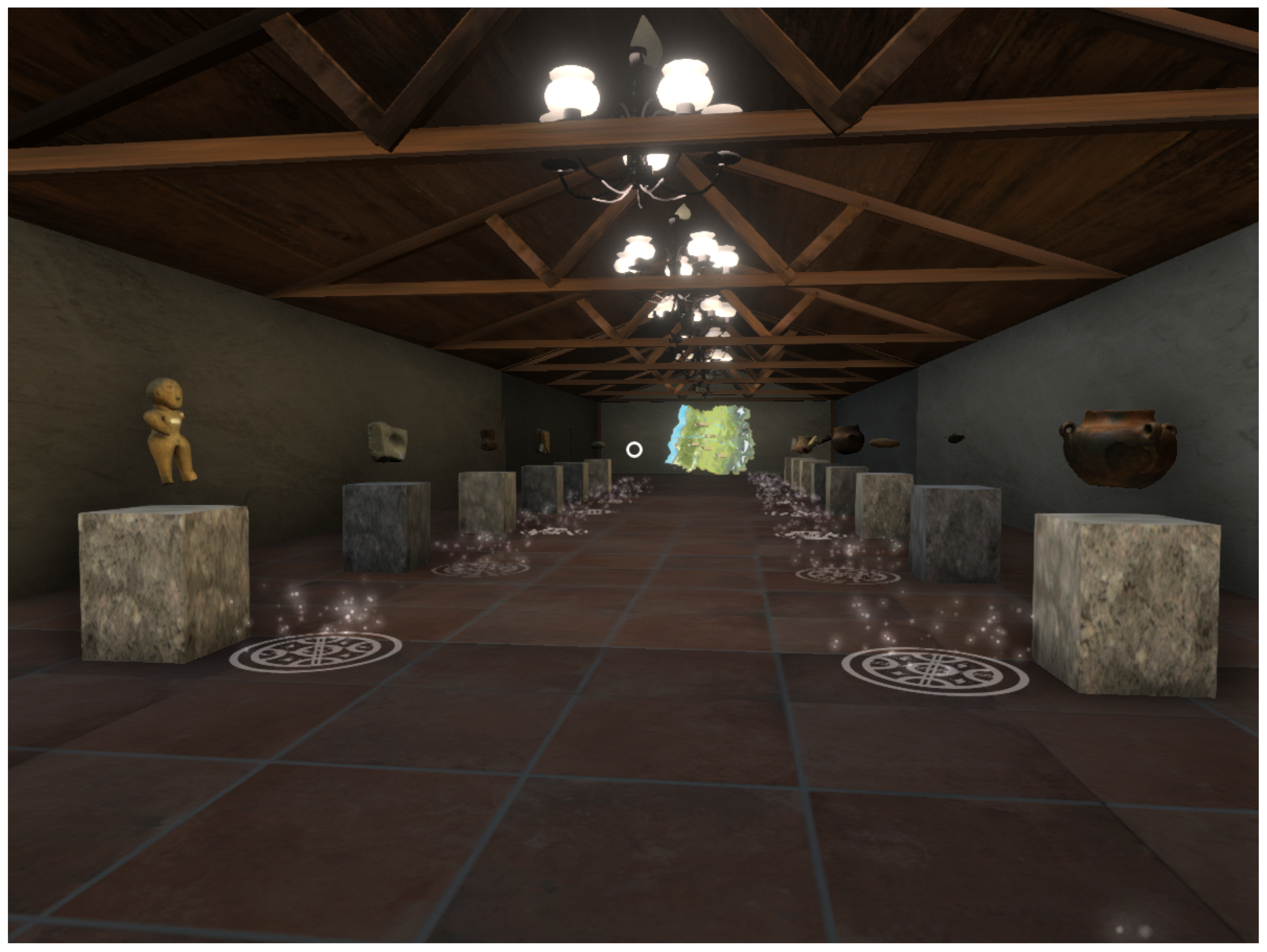
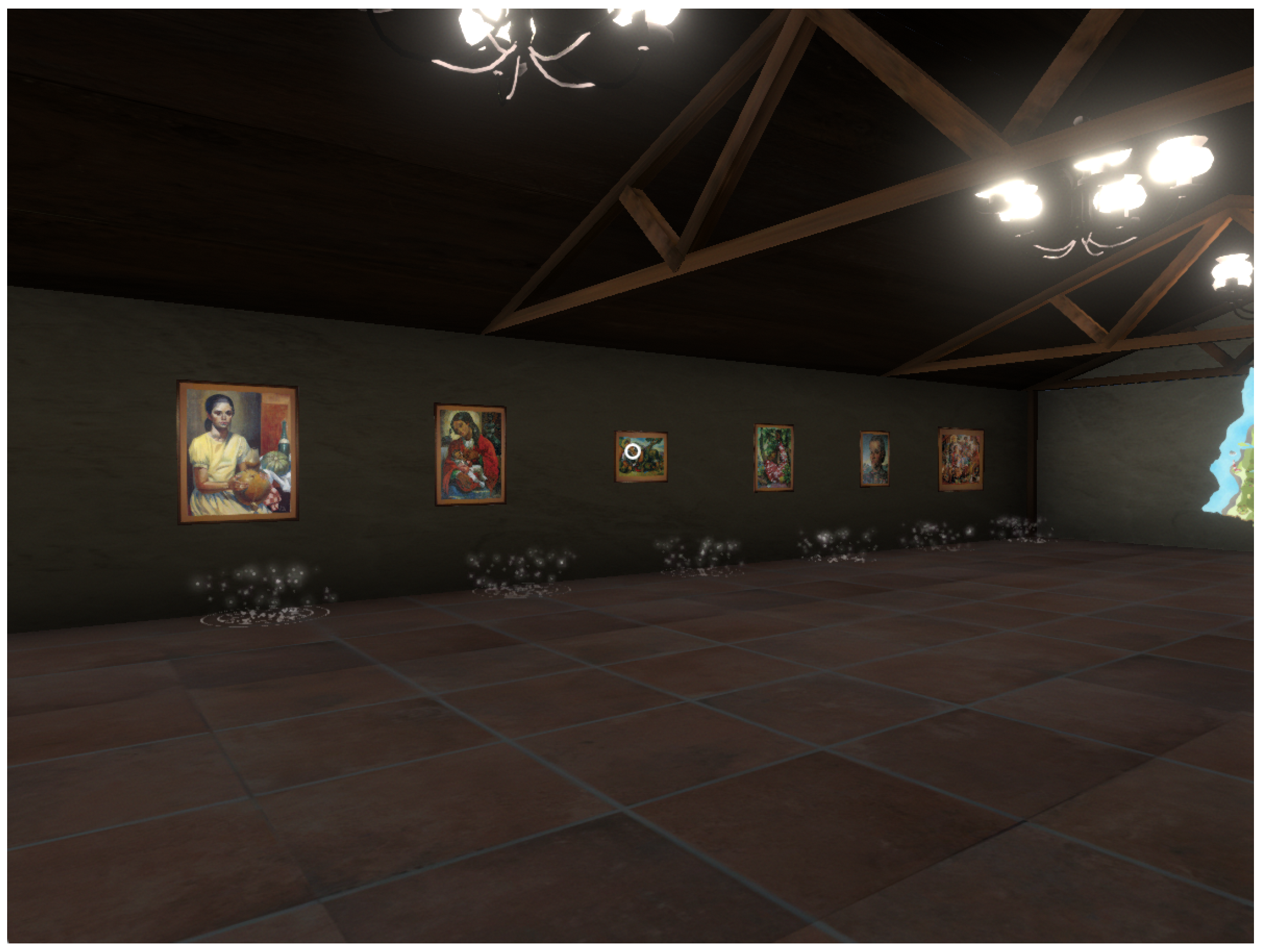
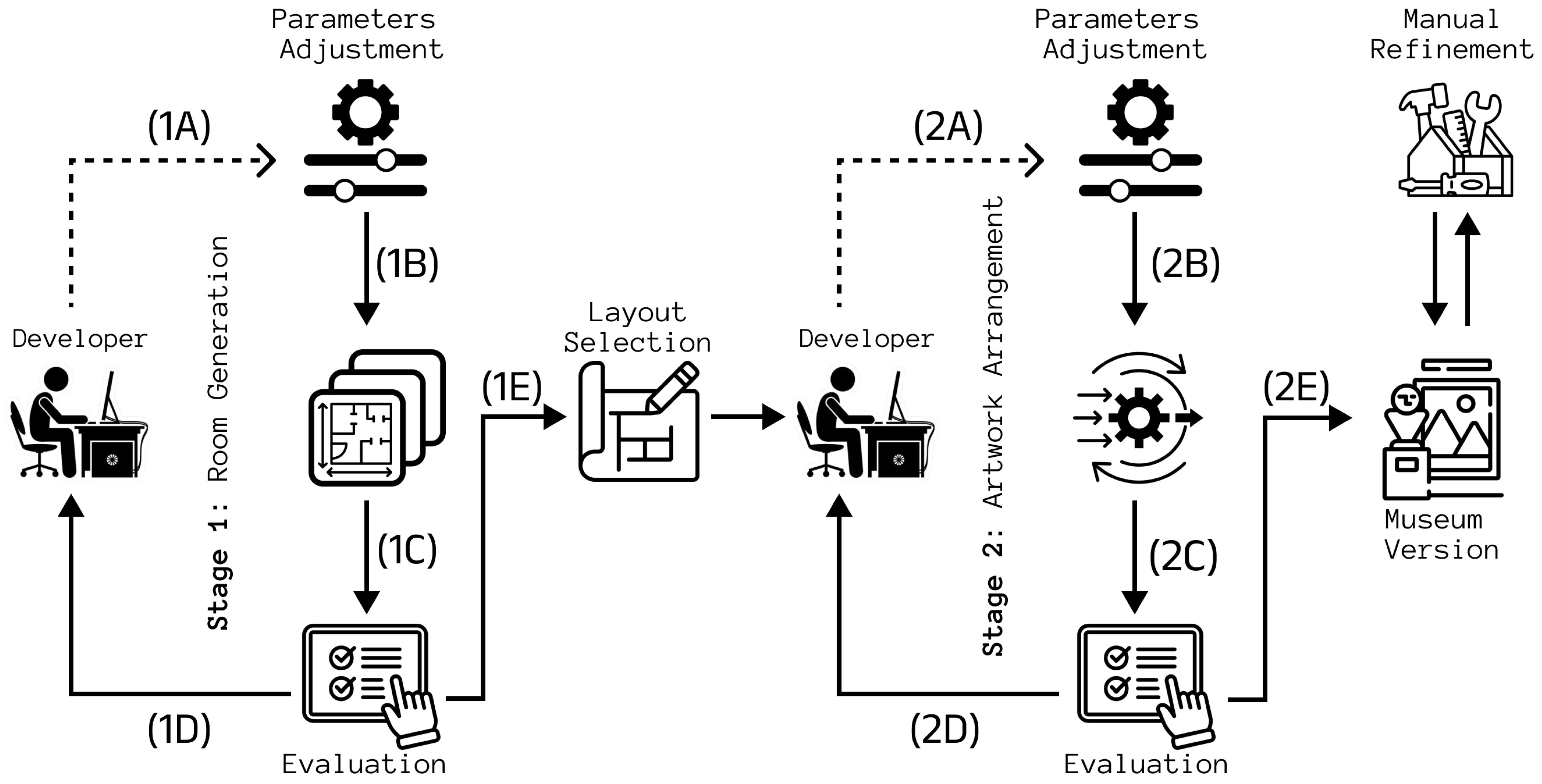
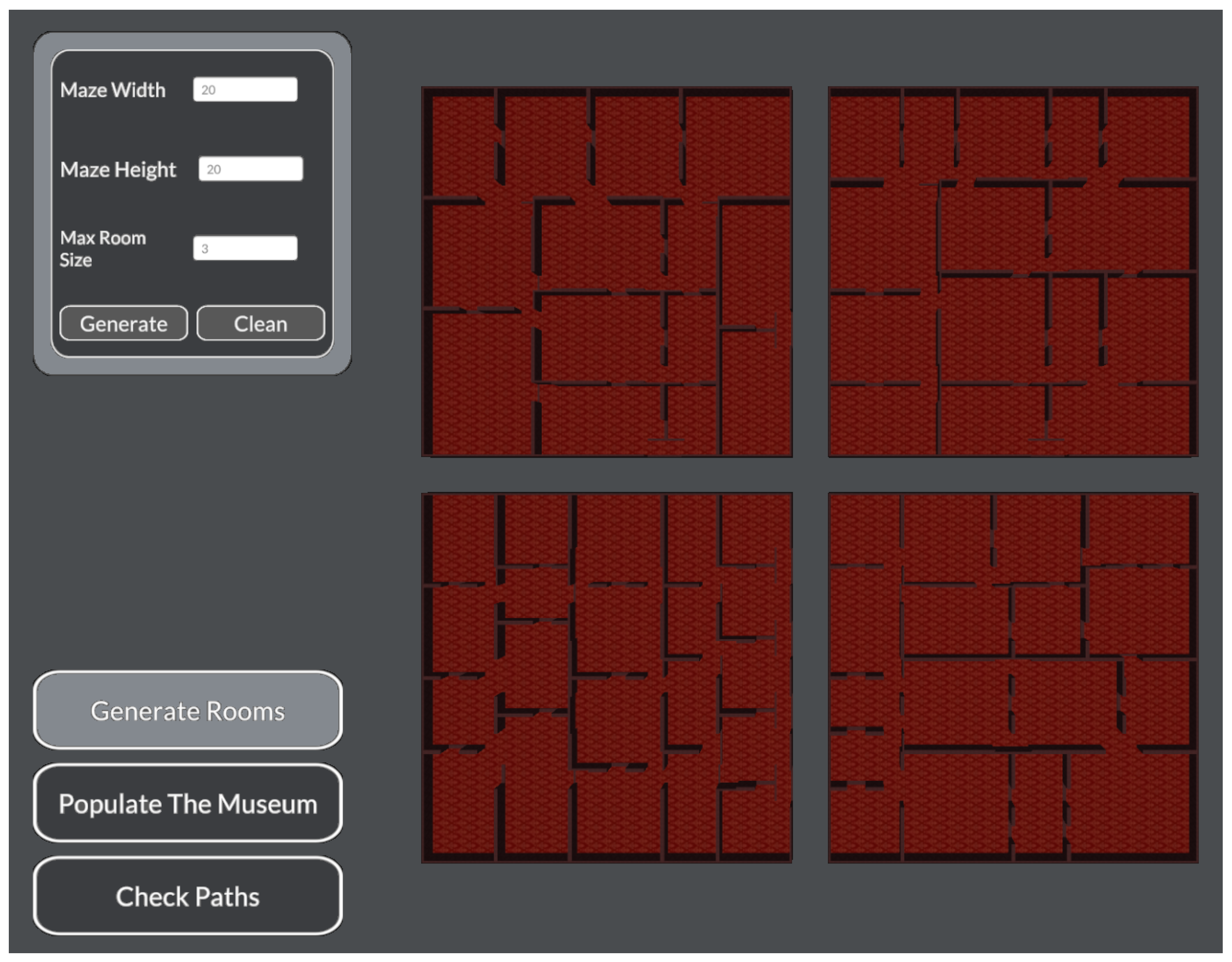


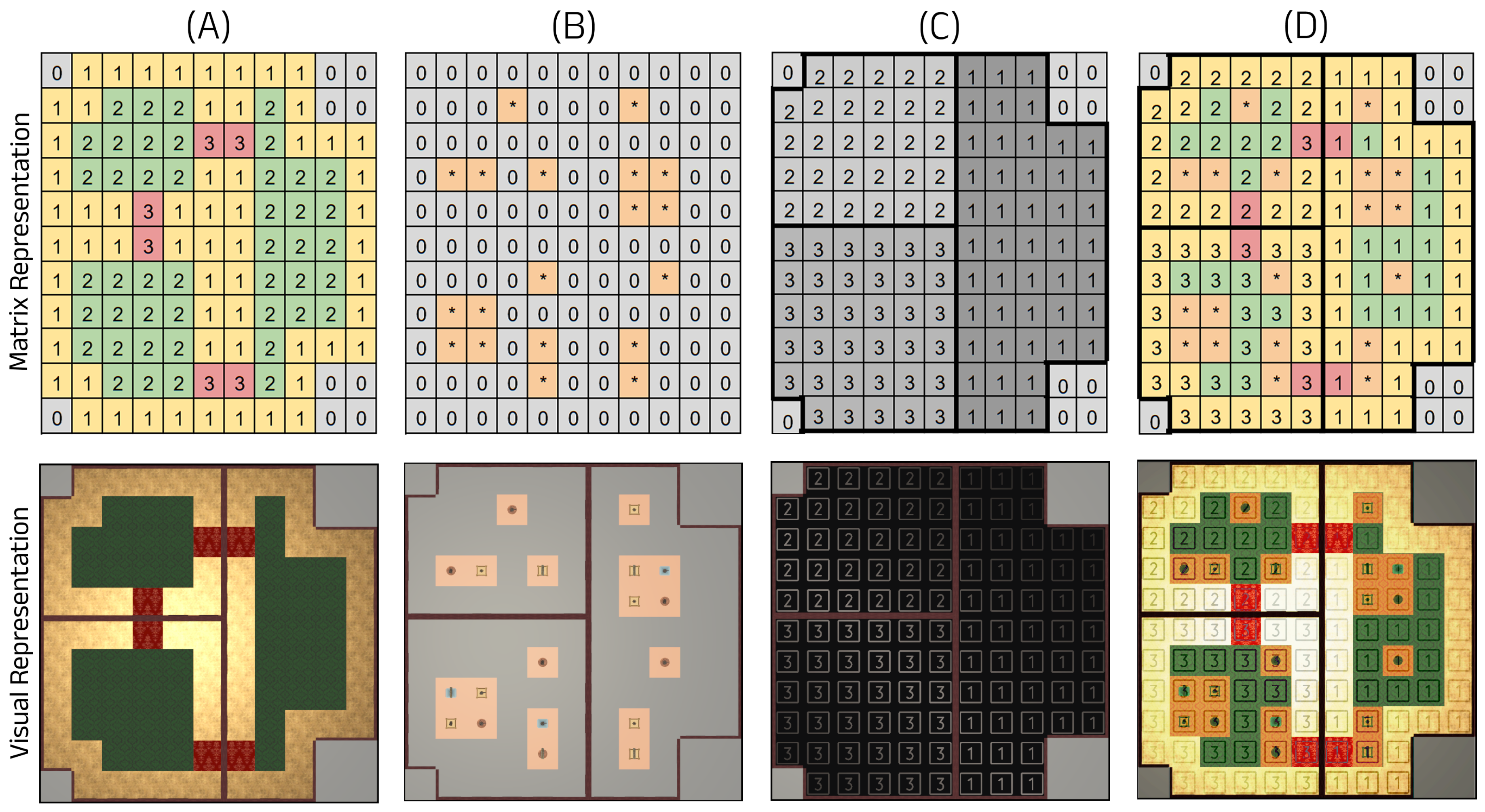

| Crossover | Mutation | Selection | Valid Chromosomes | Invalid Chromosomes | Time (ms) | Best Fitness |
|---|---|---|---|---|---|---|
| SinglePoint | Rank | 110.90 | 899.10 | 115.70 | 44.16 | |
| Inversion | Roulette | 812.90 | 197.10 | 354.00 | 39.31 | |
| Tournament | 849.50 | 160.50 | 499.60 | 44.06 | ||
| Rank | 79.70 | 930.30 | 109.20 | 36.34 | ||
| RandomResetting | Roulette | 740.90 | 268.10 | 296.20 | 31.39 | |
| Tournament | 725.50 | 284.50 | 431.70 | 38.71 | ||
| Rank | 109.10 | 900.90 | 130.80 | 44.06 | ||
| Scramble | Roulette | 825.20 | 184.80 | 369.60 | 38.71 | |
| Tournament | 851.40 | 158.60 | 503.30 | 43.96 | ||
| Rank | 97.30 | 912.70 | 105.90 | 44.26 | ||
| Swap | Roulette | 804.30 | 205.70 | 300.00 | 32.08 | |
| Tournament | 812.40 | 197.60 | 484.60 | 44.26 | ||
| TwoPoint | Rank | 293.20 | 716.80 | 89.50 | 43.76 | |
| Inversion | Roulette | 843.10 | 166.90 | 336.80 | 38.32 | |
| Tournament | 893.00 | 117.00 | 487.30 | 43.76 | ||
| Rank | 75.90 | 934.10 | 90.70 | 36.04 | ||
| RandomResetting | Roulette | 750.60 | 259.40 | 300.30 | 32.08 | |
| Tournament | 722.90 | 287.10 | 428.80 | 38.12 | ||
| Rank | 285.80 | 724.20 | 102.00 | 44.16 | ||
| Scramble | Roulette | 840.60 | 169.40 | 363.30 | 39.50 | |
| Tournament | 863.30 | 146.70 | 504.00 | 44.16 | ||
| Rank | 92.80 | 917.20 | 113.50 | 44.55 | ||
| Swap | Roulette | 799.80 | 210.20 | 335.70 | 34.65 | |
| Tournament | 832.50 | 177.50 | 526.10 | 44.55 | ||
| Uniform | Rank | 146.30 | 863.70 | 120.40 | 44.16 | |
| Inversion | Roulette | 792.00 | 218.00 | 389.00 | 43.07 | |
| Tournament | 863.80 | 146.20 | 515.80 | 44.16 | ||
| Rank | 73.40 | 936.60 | 78.50 | 35.15 | ||
| RandomResetting | Roulette | 712.20 | 297.80 | 285.30 | 30.50 | |
| Tournament | 688.60 | 321.40 | 417.60 | 37.03 | ||
| Rank | 150.20 | 859.80 | 128.40 | 44.26 | ||
| Scramble | Roulette | 808.60 | 201.40 | 349.50 | 40.20 | |
| Tournament | 854.30 | 155.70 | 506.00 | 44.26 | ||
| Rank | 128.20 | 881.80 | 109.00 | 44.55 | ||
| Swap | Roulette | 795.70 | 214.30 | 354.90 | 39.31 | |
| Tournament | 835.80 | 174.20 | 522.00 | 44.55 |
Disclaimer/Publisher’s Note: The statements, opinions and data contained in all publications are solely those of the individual author(s) and contributor(s) and not of MDPI and/or the editor(s). MDPI and/or the editor(s) disclaim responsibility for any injury to people or property resulting from any ideas, methods, instructions or products referred to in the content. |
© 2025 by the authors. Licensee MDPI, Basel, Switzerland. This article is an open access article distributed under the terms and conditions of the Creative Commons Attribution (CC BY) license (https://creativecommons.org/licenses/by/4.0/).
Share and Cite
Rubio, C.; Barriga, N.A.; Ingram, B.; Luna-García, H.; Besoain, F. Exploring Procedural Content Generation of Environments for Virtual Museums: A Mixed-Initiative Approach. Heritage 2025, 8, 134. https://doi.org/10.3390/heritage8040134
Rubio C, Barriga NA, Ingram B, Luna-García H, Besoain F. Exploring Procedural Content Generation of Environments for Virtual Museums: A Mixed-Initiative Approach. Heritage. 2025; 8(4):134. https://doi.org/10.3390/heritage8040134
Chicago/Turabian StyleRubio, Claudio, Nicolas A. Barriga, Ben Ingram, Huizilopoztli Luna-García, and Felipe Besoain. 2025. "Exploring Procedural Content Generation of Environments for Virtual Museums: A Mixed-Initiative Approach" Heritage 8, no. 4: 134. https://doi.org/10.3390/heritage8040134
APA StyleRubio, C., Barriga, N. A., Ingram, B., Luna-García, H., & Besoain, F. (2025). Exploring Procedural Content Generation of Environments for Virtual Museums: A Mixed-Initiative Approach. Heritage, 8(4), 134. https://doi.org/10.3390/heritage8040134









